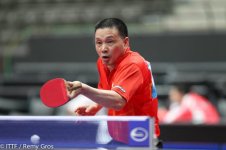Although there are some really great rallies that are produced by the top players, the one style of play I think is a little unhealthy for the sport, as is the Chinese dominance over the sport. The consistency of the style seen in top level play and the way it smothers the other styles of play makes it so that the other styles might as well not exist.
Although that was an exaggeration, it does seem that table tennis is heading in this direction, given the way it has changed over time. At top level play, the other styles seem much less relevant, and the rallies seem to be the same ones over and over. Even the choppers have to be part-time attackers.
*****************
So, how can this be fixed, or should it be fixed at all?
Topics like this come up very often in video games. The most efficient, popular, and powerful strategy and style of play is usually called 'the meta' or 'the metagame'.
Normally in games, the game developers are not happy when one aspect and style of play is clearly stronger than everything else. The developers implement balance changes to fix these problems, like making the other strategies slightly better (called a buff)or decreasing the efficacy of the meta (called a nerf) or both.
If done well, some players who played the meta might be sad, but mostly everyone else is happy with the more diverse meta.
However, if done badly (which most of the time, it is done badly), either nothing will change if nothing much is done, or too much is done. If it's the latter, a lot of players will be angry, angry that the Gods of their game killed the style of play that they spent so much time on, forcing them to take on a different approach or quit the game.
***************
In table tennis, the ones that decide the rules of the game (and consequently, the metagame), is ITTF and the laws of physics. We cannot change the laws of physics (sadly), and the laws of physics makes topspin a much more viable shot, due to the Magnus effect. So this gives a huge advantage to attackers. Along with rule changes that ITTF has made over time, the sport has evolved, and the players have evolved with it, and the players found that two-winged attackers performed the best.
So what does that mean for players like us and for spectators?
For players like us, it forces us to play into and around the meta if we want to improve our game. We all learn how to loop because looping is so great (which makes it meta). We all learn to block loops, since looping is the meta. We all learn to give short balls, since looping is the meta. Better players learn to attack short balls, since short balls is in the meta. They also have to learn to counterloop, since looping is the meta. Some people even learn to chop, to SPECIFICALLY counter the loop, since looping is the meta. And so on.
The fact that we HAVE to learn all of this is quite discouraging. It is basically the ONLY way to get better and beat other people. And what sucks is that, as players, this is what we are forced to play against, all the time. No other real option or choice.
As for spectators, most don't really know what's going on, but if they see the ball going back and forth, it's great for them.
Changes in the meta would be really interesting for players like us, but for spectators, it might not be fascinating to them.
************
So what can be done? I'm pretty sure that ITTF is sure to make looping stay in the game forever now, since it's cool to watch for the spectators. Also, if they make looping harder to do or make looping less effective (by making rule changes to the ball/rubber/net/etc), I'm sure tons of people will be mad, since they've poured so many hours into topspinning, including myself.
So since nerfing the meta basically out of the picture, the only other option is the make the other strategies better. I'm not really sure how this can be done though. Somebody would have to devise high level techniques or a new strategy that can counter the meta.
************
FINALLY: Are there advantages to keeping the status quo?
In fact, yes. If everyone is playing the same way, it is very easy to determine who is better than who. It is very easy to measure skill when everyone plays the same way.
Imagine it was not this way. Imagine different style of play have come to fruition. Different players play in different ways. Some players might not play so well against this style or that style. Some players play this style better. And so on.
It is very possible that a rock-paper-scissors meta will emerge: one style beats another, which beats the third, which beats the first. At that point, whenever someone wins or loses, it will be 'because of the style'. And so because it is less about skill now and more about match-up, it kind of sucks for the players.
Now this actually isn't all theory, because this actually does happen in video games. Certain styles will do better against one another, and the dominant ones will rise to the top. Either one of the styles emerges supreme and annihilates the others, or the multiple styles keep one another in balance.
*************
So long story short: There are advantages and disadvantages for a sport to have a dominant style. Same with having multiple viable styles.
So, to sum it up with video game examples, would we want uniformity like this:
http://i.imgur.com/tMfeyjY.png
or rock-paper-scissors like this:
https://clashroyalearena.com/wp-content/uploads/2017/05/slight-advantage-clash-royale-2.png
EDIT: for more clarity










